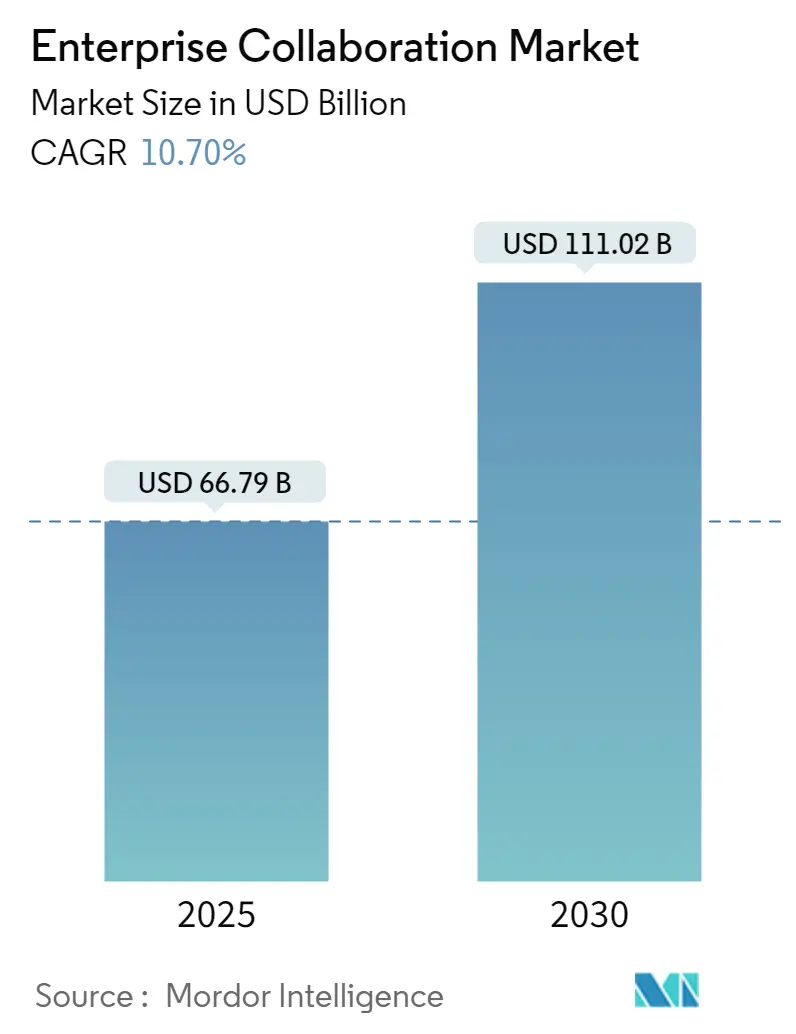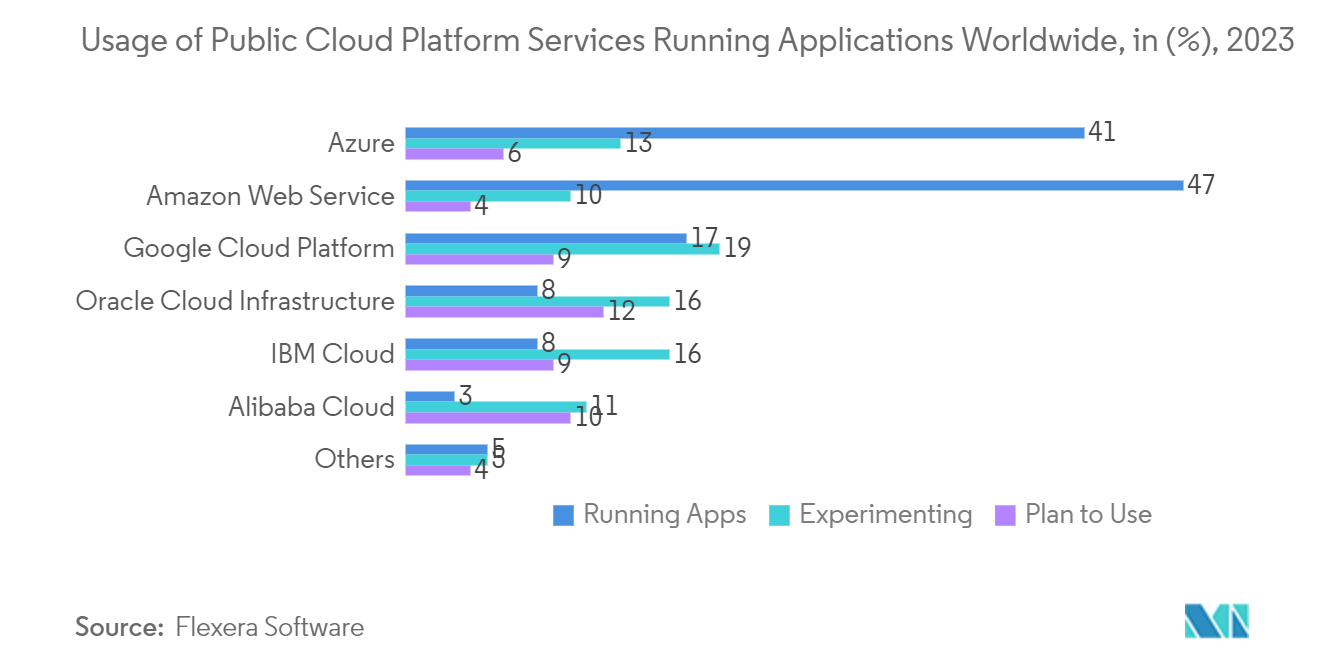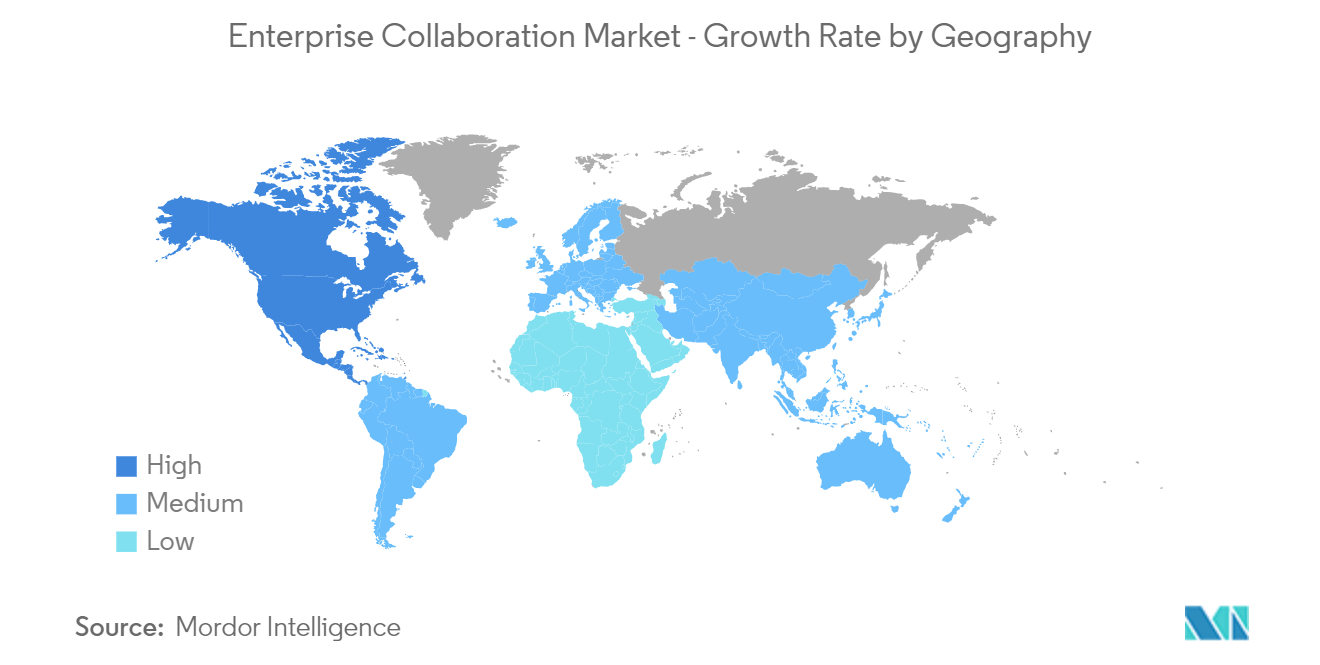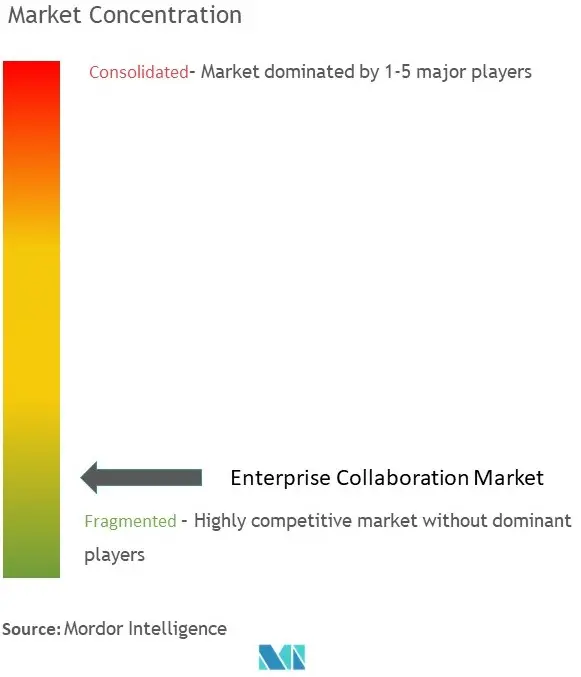
Enterprise Collaboration Market Analysis
The Enterprise Collaboration Market size is estimated at USD 66.79 billion in 2025, and is expected to reach USD 111.02 billion by 2030, at a CAGR of 10.7% during the forecast period (2025-2030).
Enterprises utilize advanced tools like virtual reality, robotic process automation, and artificial intelligence bots to augment internal productivity and promote better employee communication. According to Goldman Sachs, the virtual and augmented reality market's enterprise and public sector segments are expected to account for around USD 16.1 billion by 2025. Virtual reality companies, such as RealSense and DORA, offer immersive experiences for the boardroom.
- Enterprise collaboration tools help firms by providing seamless communication between employees and improving their operational efficiency and productivity, helping them meet their business goals. Enterprise collaboration tools provide data synchronization and collaboration solutions across organizations and include features such as checking official emails, calendars, and contacts. Furthermore, video conferencing helps to give the employees more engaging communication and sharing of ideas.
- Advanced technologies such as AI, IoT, and ML are being implemented into enterprise collaboration tools to enhance collaborative capabilities. AI-based enterprise collaboration tools can track the activities of employees and the contents being shared and are used to deliver anticipated business insights to the employees and help get the work done quicker by correlating visual analytics with production checkpoints such as consumer behavior, employee retention, office utilization, and performance optimization.
- The cloud-based deployment of workloads is anticipated to be primarily driven by the consistent growth in the generated data. Various end-user industries are dealing with a massive volume of data being generated. The data centers are more suited for an organization that has to run many applications and complex workloads for enterprise collaboration. It also enables high productivity, with access to real-time data with all application tools.
- For instance, in August 2022, Microsoft announced the launch of its new data center region in Qatar, marking a significant possibility for Microsoft as the most significant hyperscale cloud provider to offer enterprise-grade services in the country. The latest cloud data center region launches with Microsoft Azure and Microsoft 365, giving organizations access to hundreds of scalable, highly available, and resilient cloud services.
- The growing usage of mobile devices to operate numerous social networking platforms boosts the enterprise collaboration market growth. It is observed that few people access social networking sites via computers, while most people use smartphones to access these websites. For instance, recently, more than 50% of web traffic in the United States originated from mobile devices, and according to the latest data, mobile internet users in the United States are forecast to reach 300 million by 2026.
- Furthermore, emerging economizing, such as China and India, are also experiencing a similar trend, owing to the increasing usage of smartphones due to their easy accessibility. These advantages are propelling the growth of the enterprise collaboration market. According to Ericsson, smartphone mobile network subscriptions worldwide reached almost 6.6 billion in 2022 and are forecast to exceed 7.8 billion by 2028. India, China, and the U.S. have the highest smartphone mobile network subscriptions.
- Data privacy concern is one of the significant challenges for the growth of the enterprise collaboration market. While many enterprises focus on preventing malicious data hacking and theft, data breaches are most commonly caused due to lack of data security or accidental mishandling. Furthermore, as enterprises step toward a more collaborative environment, the exchange of data increases, both within the company and with external enterprises. With the increasing data exchange among enterprises and employees, there is a growing need to address the challenges of safeguarding shared data during collaboration activities. Such challenges are hampering the market growth at a certain level.
Enterprise Collaboration Market Trends
Cloud-based Deployment to Increase the Market Growth
Cloud-based deployment to workload is expected to be primarily driven by the consistent growth in the data generated. Several industry verticals are dealing with a massive volume of data. A data center is better suited for an organization that runs many kinds of applications and complex workloads for enterprise collaboration. It enables high productivity, with access to real-time data with all application tools.
Enterprise social collaboration (ESC) solutions have connected people worldwide in recent years. Social applications have been limited by technology and may work fine for one department but not for another. The advent of the cloud makes integrating social collaboration solutions more effortless. Most SMEs (small and medium enterprises) are adopting cloud deployment, as these solutions help SMEs avoid hardware, software, storage, and technical staff costs. It also helps in the scalability of data in the collaboration market.
The market players deliver cloud-based platforms with more features and functionality, avoiding organizations needing to integrate, implement, and manage several standalone systems. Such advantages of cloud-based deployment over on-premises are expected to boost the market growth. According to Flexera Software, in 2023, 47% of respondents are already running significant workloads on Amazon Web Services (AWS).
The expansion of organizations globally, increased productivity, and growth in the trend of bringing devices (BYOD) and the IoT are some significant factors expected to boost the growth of the cloud-based enterprise collaboration market. With the development of cloud-based Enterprise collaboration solutions, including telephony, teleconferences, and social collaboration software, enterprises collaborate efficiently and rapidly, maintain good relationships with clients, and immediately respond to queries, allowing market growth.
According to the Ministry of Corporate Affairs (India), as of June 2022, there were around 1.48 million registered companies in the South Asian country of India. In addition, According to BetterCloud, In 2022, organizations worldwide were using an average amount of 130 cloud-based software as a service (SaaS) applications. Since 2015, the number of SaaS apps enterprises use has constantly increased, which may further drive market growth.
Hybrid landscapes of public and private cloud applications require integration in a homogeneous cloud coordinated with the right tools. For instance, a German-based company, T-Systems, operates dynamic services for collaboration in the high-security private cloud, fully compliant with the country's strict data privacy and protection laws.
Therefore, the growing demand for applications across various sectors in emerging economies also boosts viability, providing relevant cloud security solutions. As most enterprises across regions engage in these technology services, the usage of the cloud collaboration market expands and drives the growth of the overall market.

North America to Experience Significant Market Growth
North America significantly holds the market share in the enterprise collaboration market due to the presence of market players such as Facebook Inc., Microsoft Corporation, Google LLC, and Slack Technologies Inc. These organizations provide technologically advanced solutions and products to small- and large-scale companies to boost their productivity by facilitating enhanced internal and external communications. This region has an advanced infrastructure capability, which has led it to become a significant revenue generator for the market. Such factors would further augment regional market growth in the coming years.
Companies in the region are moving beyond the public cloud and stepping into a new era of hybrid IT, which combines public cloud, private cloud, and traditional IT. These organizations have implemented a hybrid cloud strategy as it helps improve how they run their collaboration business.
In June 2022, Google Cloud launched a unique 'Google Public Sector' subsidiary focusing on the United States. The division will sell to national, state, and local governments and educational associations. This latest division will serve as a subsidiary of Google LLC and will specialize in bringing Google Cloud technologies, including Google Cloud Platform and Google Workspace, to US public sector customers.
In the current scenario, information is shared using mobile phones, video conferencing, instant messenger, and others that deliver information within a stipulated time. With collaborative communication, the congestion overload is reduced significantly, thus providing ease of contact. For better communication, firms are making every effort to have cloud and collaboration technology mutually available, which drives the growth of the Enterprise Collaboration Market.
According to Oberlo, North America has 225 billion social media users and 373 billion mobile subscriptions. This will enable enterprises to process memos and training resources and share industry-relevant news updates. Enterprise collaboration solutions and services have gained wide adoption in the region, particularly in the US, as the nation has been one of the earliest adopters of Social, Mobile, Analytics, and Cloud (SMAC) technologies.
Organizations such as the US Joint Forces Command, the US Department of Defense, and many local and state agencies have started to use collaborative technologies to build internal and external knowledge repositories. Companies are customizing their offerings to stay competitive in the market. US-based Dropbox announced its more recent version in August 2022, an enterprise software portal. It allows users to launch apps with shortcuts and use built-in Slack message-sending and Zoom video calls.
Enterprise Collaboration Industry Overview
The enterprise collaboration market is favorably fragmented. The top players aim for a large share of the market, while the numerous smaller players aim for a substantial pie of the market. This results in intense rivalry and competition. Key participants in the market are Microsoft Corporation, Huawei Technologies Co. Ltd, Adobe Systems Inc., etc. Some of the recent developments in the market are -
July 2022: Microsoft introduced the launch of the Microsoft Cloud for Sovereignty, a unique solution for public sector customers, mainly in Europe. With the addition of Microsoft Cloud for Sovereignty, companies will have greater control over their data and expanded transparency to the operational and governance procedures of the cloud.
January 2022: Tata Consultancy Services (TCS) is currently a partner for the newly-launched Microsoft Cloud for Retail, expanding its collaboration with the hyper-scale. TCS will combine its deep industry knowledge from working with significant retailers worldwide and its multi-horizon cloud transformation framework to assist retail clients in accelerating their growth and transformation journeys using Microsoft Cloud for Retail. Microsoft Cloud for Retail is a secure industry-specific cloud that combines various Microsoft technologies linked by a standard data model to connect experiences across the end-to-end shopper journey with integrated and intelligent capabilities.
Enterprise Collaboration Market Leaders
-
Microsoft Corporation
-
Huawei Technologies Co. Ltd.
-
Adobe Systems Inc.
-
SAP SE
-
IBM Corporation
- *Disclaimer: Major Players sorted in no particular order
Enterprise Collaboration Market News
- April 2023: Google Cloud launched an AI-enabled platform for prior authorization and claims processing powered by a new data and analytics tool. The latest offering will convert unstructured data into structured data and can help payers meet existing and proposed CMS rules around interoperability and prior authorization, including using HL7 FHIR.
- February 2022: IceWarp, a global player in developing unified collaboration tools and messaging solutions for companies of all sizes, expanded its presence in the Middle East by opening its first office in the prime area of Business Bay in Dubai. IceWarp provides businesses with affordable, seamlessly integrated, easy-to-use communication solutions that protect all corporation collaboration and productivity aspects.
Enterprise Collaboration Industry Segmentation
Enterprise collaboration is a technique of communication that makes it more comfortable for employees to work together on required projects, even if they are not in the same office. The international pandemic accelerated existing trends in remote work, as companies had to give their employees more flexible options. The studied market is segmented by On-premise and Cloud-based deployments among applications such as Communication Tools, Conferencing Tools, and Coordination Tools.
The enterprise communication & collaboration system market is segmented by deployment (On-premise, cloud-based), by application (communication tools, conferencing tools, coordination tools), by end-user industry (telecommunications and IT, travel, and hospitality, BFSI, retail and consumer goods, education, transportation, and logistics, healthcare), and by geography (North America [United States, Canada], Europe [United Kingdom, Germany, France, Spain], Asia Pacific [China, Japan, India, South Korea], Latin America, Middle East Africa) . The report offers market forecasts and size in value (USD) for all the above segments.
| By Deployment Type | On-premise | ||
| Cloud-based | |||
| By Application | Communication Tools | ||
| Conferencing Tools | |||
| Coordination Tools | |||
| By End-user Industry | Telecommunications and IT | ||
| Travel and Hospitality | |||
| BFSI | |||
| Retail and Consumer Goods | |||
| Education | |||
| Transportation and Logistics | |||
| Healthcare | |||
| Other End-user Industries | |||
| By Geography | North America | United States | |
| Canada | |||
| Europe | United Kingdom | ||
| Germany | |||
| France | |||
| Spain | |||
| Asia | China | ||
| Japan | |||
| India | |||
| South Korea | |||
| Australia and New Zealand | |||
| Latin America | |||
| Middle East and Africa | |||
Enterprise Collaboration Market Research FAQs
How big is the Enterprise Collaboration Market?
The Enterprise Collaboration Market size is expected to reach USD 66.79 billion in 2025 and grow at a CAGR of 10.70% to reach USD 111.02 billion by 2030.
What is the current Enterprise Collaboration Market size?
In 2025, the Enterprise Collaboration Market size is expected to reach USD 66.79 billion.
Who are the key players in Enterprise Collaboration Market?
Microsoft Corporation, Huawei Technologies Co. Ltd., Adobe Systems Inc., SAP SE and IBM Corporation are the major companies operating in the Enterprise Collaboration Market.
Which is the fastest growing region in Enterprise Collaboration Market?
Asia Pacific is estimated to grow at the highest CAGR over the forecast period (2025-2030).
Which region has the biggest share in Enterprise Collaboration Market?
In 2025, the North America accounts for the largest market share in Enterprise Collaboration Market.
What years does this Enterprise Collaboration Market cover, and what was the market size in 2024?
In 2024, the Enterprise Collaboration Market size was estimated at USD 59.64 billion. The report covers the Enterprise Collaboration Market historical market size for years: 2019, 2020, 2021, 2022, 2023 and 2024. The report also forecasts the Enterprise Collaboration Market size for years: 2025, 2026, 2027, 2028, 2029 and 2030.
Our Best Selling Reports
Enterprise Collaboration Platform Industry Report
Statistics for the 2025 Enterprise Collaboration market share, size and revenue growth rate, created by Mordor Intelligence™ Industry Reports. Enterprise Collaboration analysis includes a market forecast outlook for 2025 to 2030 and historical overview. Get a sample of this industry analysis as a free report PDF download.





